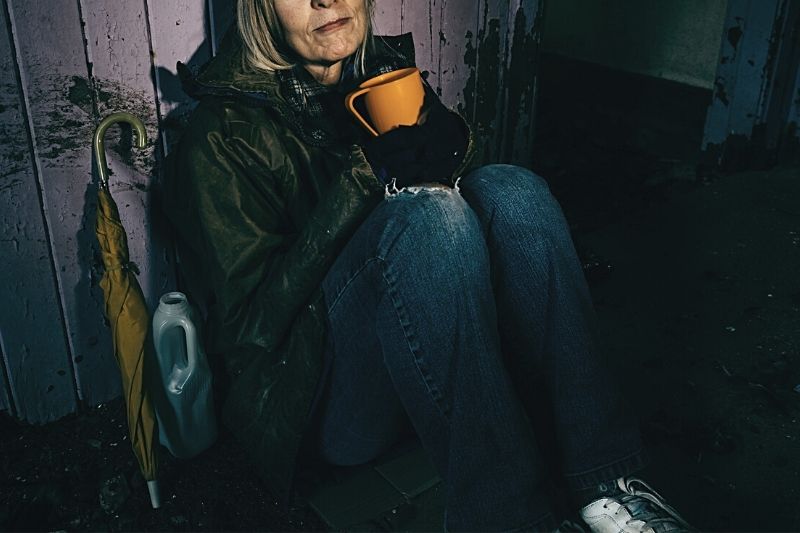Women over the age of 55 are the fastest growing cohort of homelessness in Australia. Research indicates that most of these women have never been homeless before. While domestic violence is the single biggest cause of homelessness in Australia, poverty is also a major cause. There are structural reasons as to why older women cannot afford private rental and enter a housing crisis when they age. Women often work part time during their working lives due to responsibilities of children and they also have long periods out of the workforce to have children and fulfil caring roles. As a result, they accumulate less superannuation than their male counterparts.

In 2018 ABS data revealed that women’s superannuation savings were on average 37 per cent lower than men’s at retirement. This coupled with the gender pay gap means that women will have less savings and superannuation at retirement making them more likely to become dependent on the aged pension. If they don’t own a home at retirement they enter a very vulnerable stage of life in terms of housing security. If they become unemployed before retirement they may have to depend on Jobseeker which will vastly increase their housing insecurity and put them at risk of homelessness.
I have worked as a social worker in the homelessness sector for sixteen years, providing support to single adults. During this time, I have noticed a significant increase in the number of single older women presenting for support as they are homeless. They are not the rough sleepers seen sleeping on the streets but are the invisible homeless who are couch surfing or sleeping in cars.
There have been many reports of the current housing crisis that has taken hold in recent times. Property market analyst, PropTrack has reported that in February 2023, only 17 per cent of all rentals listed on realestate.com across Australia were for properties priced at $400.00 or less per week. In Feb 2020, 43 per cent of properties were listed for this price. The dramatic increase in rental prices, rental supply not meeting demand and the long-term shortage of affordable social housing has certainly placed enormous pressure on those who are looking to secure rental accommodation.
Anglicare released a rental Affordability Report in April this year which highlighted a private rental market in crisis, stating that rents have never been as unaffordable as they are today. The standard calculation for rental affordability is 30 per cent of income. The findings from this report are alarming. Anglicare took a snapshot of 45,985 national listings on realestate.com over the weekend of March 17, 2023 and found that only 162 of the properties were affordable for a single person on the aged pension. This was a decrease from 312 properties that were affordable when the snapshot was taken in 2002. A single person on a minimum wage could only afford 345 of these properties. This was a decrease from 720 in the snapshot taken in 2022. A person on Jobseeker could only afford 4 of the properties. Those 4 being rooms to let in Rooming Houses. This was a decrease from 7 in the snapshot taken in 2002. There are currently over 172,000 women over the age of 50 on Jobseeker in Australia. None of these could afford private rental.
With more people entering the rental market due to housing ownership unaffordability, there is an extremely high demand for rental properties along with a current low supply. Agents in the real estate market have reported to me that they are now capping the number of people that they will accept for inspections. From the many applications that they receive, they can select the most financially secure tenant for the property.
ABS data reveals that there was a 97 per cent increase in older female renters over a period of 10 years from 2006 to 2016. Older women on pensions who are looking to rent are one cohort who are severely disadvantaged by the current situation in the rental market and are really struggling to find an affordable home. I have heard many reports of older women attending many inspections and lodging over one hundred applications for properties only to be knocked back each time. They have reported that they feel overlooked at inspections, ‘The agent just doesn’t seem to notice that I am there. It was like he was an actor on a stage and I was one of the props.’ A sense of being invisible in a world which prioritizes the younger worker with income capacity.

'Governments need to build more social housing than they have promised. As well as this, more safe emergency accommodation is required. Beyond this, the structural forces in terms of wage inequity, income support and rental and housing unaffordability that are creating this huge wave of homelessness need to be addressed.'
There is minimal suitable crisis accommodation in Melbourne for an older woman. Some Community organisations manage Rooming Houses for women but there is low vacancy rate in this type of accommodation. The majority of crisis accommodation that is available in most parts of Melbourne is in the form of privately managed Rooming Houses. These houses are managed by private landlords and often house up to ten people at a time. Many of the occupants are male and are suffering from mental health problems, substance abuse or have exited there from prison. The environment is often volatile in this type of accommodation. An older woman would be very vulnerable and would not feel safe in this type of environment. If they have no family to turn to for support, there is no option for them other than to sleep in their cars or couch surf if they are homeless. There they wait languishing on the social housing waitlist for many years while they await their allocation of housing. If they are not eligible for social housing they have no option other than attempting to access the private rental market which is now unaffordable and virtually impossible to access.
Affordable social housing could be an option if the older person met the criteria and was able to manage to languish on the waitlist for many years. However, there is a growing cohort of older women, who can’t access the private rental market who don’t meet the eligibility criteria for social housing because they have some money in savings which puts them over the asset limit for social housing. The asset limit for priority social housing in Victoria is $14,364.00. Anyone over the asset limit may be eligible for a Register of Interest if they have assets under $36.340.00 however if waitlisted under this category it is unlikely that they will ever receive an allocation of Social Housing. Under the priority category they will still wait many years for housing depending on the priority type.
For many decades now there has been a scarcity of social housing. Governments have failed to build more affordable housing and this has resulted in extremely long waitlists for those who qualify for this type of housing. The number of people waiting on the Social Housing waitlist in Victoria has increased from 35,392 in June 2017 to 54,945 in March 2023. While the Andrews Government committed to build 12,000 social, affordable homes in 2020, this will only address the tip of the iceberg as there are so many people already waiting on the social housing waitlist and more people will require this type of housing due to the unaffordable private rental market.
The recent Federal Government budget included some new measures to increase social housing supply, however homelessness advocates are reporting that this will not end homelessness in Australia as more people enter homelessness due to the current economic pressures and housing crisis. Mission Australia has stated that the affordable and social housing supply will need to increase by almost one million over the next 20 years to meet this growing demand.
Governments need to build more social housing than they have promised. As well as this, more safe emergency accommodation is required. Beyond this, the structural forces in terms of wage inequity, income support and rental and housing unaffordability that are creating this huge wave of homelessness need to be addressed.
Jennifer McVeigh is a social worker in the Homelessness Sector in Melbourne.
Main image: Elderly homeless senior woman. (Getty images)